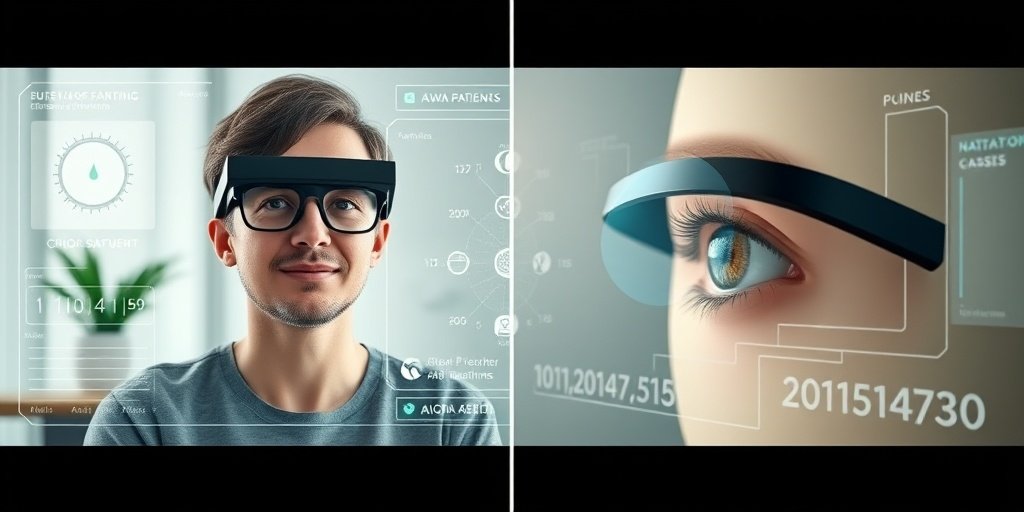⚡ Quick Summary
This study introduces a groundbreaking method for detecting Major Depressive Disorder (MDD) using wearable point-of-view (POV) glasses combined with machine learning. The multimodal analysis achieved an impressive accuracy of 84.7%, highlighting its potential as an objective tool in psychiatric assessments.
🔍 Key Details
- 📊 Participants: 44 MDD patients and 41 healthy controls
- 🧩 Features analyzed: Visual (gaze distribution, smiling duration) and speech (response latency, silence ratio)
- ⚙️ Technology: Machine learning classifiers, primarily ExtraTrees
- 🏆 Performance metrics: Accuracy 84.7%, Sensitivity 90.9%, Specificity 78%, F1 Score 86%
🔑 Key Takeaways
- 👓 POV glasses provide a novel way to capture behavioral data for depression detection.
- 💡 Machine learning effectively differentiates between MDD patients and healthy individuals.
- 📈 High accuracy of 84.7% demonstrates the potential of this technology in clinical settings.
- 🔍 Significant features include smiling duration and gaze patterns, which correlate with MDD.
- 🌍 Future research should focus on larger, more diverse populations to validate findings.
- 🧠 Objective assessments could enhance clinical decision-making in mental health.
- 📅 Study published in Front Psychiatry, 2025.

📚 Background
Diagnosing Major Depressive Disorder (MDD) has long been a challenge due to its reliance on subjective interviews and self-reports. As mental health issues continue to rise globally, there is an increasing need for objective, technology-driven methods to assist in clinical decision-making. The integration of wearable technology, such as POV glasses, offers a promising avenue for capturing real-time behavioral data.
🗒️ Study
The study involved 44 patients diagnosed with MDD and 41 age- and sex-matched healthy controls. During semi-structured interviews, participants wore POV glasses that recorded both video and audio data. The researchers focused on extracting visual features like gaze distribution and smiling duration, alongside speech features such as response latency and silence ratio. The analysis employed recursive feature elimination and evaluated multiple classifiers, with the primary model being ExtraTrees.
📈 Results
The findings revealed significant differences in behavioral markers between MDD patients and healthy controls. After applying Bonferroni correction, key features such as smiling duration and gaze patterns were identified as critical differentiators. The multimodal classifier achieved an accuracy of 84.7%, with a sensitivity of 90.9% and specificity of 78%, indicating a robust performance in distinguishing between the two groups.
🌍 Impact and Implications
This innovative approach has the potential to revolutionize how we assess and diagnose depression. By utilizing POV glasses and machine learning, clinicians can gain access to objective behavioral markers that enhance the accuracy of psychiatric evaluations. As mental health continues to be a pressing global issue, integrating such technologies could lead to improved patient outcomes and more effective treatment strategies.
🔮 Conclusion
The study highlights the transformative potential of combining wearable technology with machine learning in the field of mental health. By capturing multimodal behavioral data, we can move towards more objective assessments of conditions like MDD. Future research should aim to validate these findings in larger, more diverse populations, paving the way for broader clinical applications.
💬 Your comments
What are your thoughts on this innovative approach to depression detection? We would love to hear your insights! 💬 Leave your comments below or connect with us on social media:
A novel approach to depression detection using POV glasses and machine learning for multimodal analysis.
Abstract
BACKGROUND: Major depressive disorder (MDD) remains challenging to diagnose due to its reliance on subjective interviews and self-reports. Objective, technology-driven methods are increasingly needed to support clinical decision-making. Wearable point-of-view (POV) glasses, which capture both visual and auditory streams, may offer a novel solution for multimodal behavioral analysis.
OBJECTIVE: This study investigated whether features extracted from POV glasses, analyzed with machine learning, can differentiate individuals with MDD from healthy controls.
METHODS: We studied 44 MDD patients and 41 age/sex-matched HCs (18-55 years). During semi-structured interviews, POV glasses recorded video and audio data. Visual features included gaze distribution, smiling duration, eye-blink frequency, and head movements. Speech features included response latency, silence ratio, and word count. Recursive feature elimination was applied. Multiple classifiers were evaluated, and the primary model-ExtraTrees-was assessed using leave-one-out cross-validation.
RESULTS: After Bonferroni correction, smiling duration, center gaze and happy face duration showed significant group differences. The multimodal classifier achieved an accuracy of 84.7%, sensitivity of 90.9%, specificity of 78%, and an F1 score of 86%.
CONCLUSIONS: POV glasses combined with machine learning successfully captured multimodal behavioral markers distinguishing MDD from controls. This low-burden, wearable approach demonstrates promise as an objective adjunct to psychiatric assessment. Future studies should evaluate its generalizability in larger, more diverse populations and real-world clinical settings.
Author: [‘Kayış H’, ‘Çelik M’, ‘Çakır Kardeş V’, ‘Karabulut HA’, ‘Özkan E’, ‘Gedizlioğlu Ç’, ‘Özbaran B’, ‘Atasoy N’]
Journal: Front Psychiatry
Citation: Kayış H, et al. A novel approach to depression detection using POV glasses and machine learning for multimodal analysis. A novel approach to depression detection using POV glasses and machine learning for multimodal analysis. 2025; 16:1720990. doi: 10.3389/fpsyt.2025.1720990